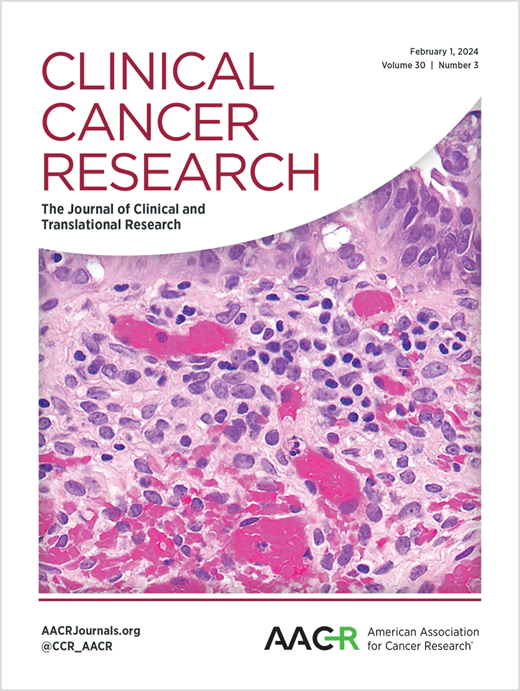瑞典前瞻性人群 SCAN-B 队列中雌激素受体低阳性乳腺癌的全球转录复杂性。
IF 10
1区 医学
Q1 ONCOLOGY
引用次数: 0
摘要
目的细胞核免疫组织化学染色1-10%的低er肿瘤是否代表BC的独特分子生物学实体尚不确定,这对其临床管理和开发新疗法提出了重大挑战。我们的目的是阐明低er肿瘤生物学。实验设计:我们分析了瑞典基于人群的SCAN-B BC队列中的原发性肿瘤,其中2% (n=174)被分类为er低。er低与er阴性患者的转录模式、肿瘤炎症浸润及预后比较(er阴性;0%)和er阳性(ER-pos;> 10%)肿瘤。结果er低和er阴性肿瘤的转录组有明显重叠;主要显示非腔内PAM50亚型和下调内质网信号。所有TNBC分子亚型均为低er / her2阴性BC。无监督聚类算法无法从TNBC肿瘤中分离出ER-low/ her2阴性,只有2个基因在组间表达差异超过1.5倍。然而,交界性ER低肿瘤(确切为10% ER)大多被赋予与腔内疾病生物学相关的标签,提示可能的内分泌反应性。淋巴细胞浸润在er -低和er -阴性之间是相当的,但相对于ER-pos肿瘤明显更高。在er -低/ her2阴性疾病中,根据RNAseq数据推断的hr阳性和低/中等PAM50 ROR评分以及淋巴细胞分数≥30%分别与较好的预后相关。结论ser -低/ her2阴性不是一种独特的BC分子生物学实体,而是TNBC的一个组成部分,值得类似的治疗。尽管如此,少数具有中度er信号活性的边缘性病例可能对ET有潜在的反应。hr相关特征和TILs可根据复发风险对er低/ her2阴性肿瘤进行分层。ET在低er型BC中的真正益处需要前瞻性研究。本文章由计算机程序翻译,如有差异,请以英文原文为准。
Global Transcriptional Complexity of Estrogen Receptor Low Positive Breast Cancers in a Prospective Swedish Population-based SCAN-B Cohort.
PURPOSE
There is uncertainty whether ER-low tumors with a 1-10% immunohistochemical staining of nuclei represent a distinct molecular biological entity of BC, posing significant challenges for their clinical management and developing novel therapies. We aimed to elucidate ER-low tumor biology.
EXPERIMENTAL DESIGN
We analyzed primary tumors included in a Swedish population-based SCAN-B BC cohort, 2% (n=174) of which were classified ER-low. Transcriptional patterns, tumor inflammatory infiltration and prognosis were compared between ER-low versus ER-negative (ER-neg; 0%) and ER-positive (ER-pos; >10%) tumors.
RESULTS
The transcriptomes of ER-low and ER-neg tumors remarkably overlapped; displaying predominantly non-luminal PAM50 subtypes and down-regulated ER signaling. All TNBC molecular subtypes were represented within ER-low/HER2-negative BC. Unsupervised clustering algorithms failed to segregate ER-low/HER2-negative from TNBC tumors and only 2 genes were significantly differentially expressed above 1.5 fold-difference between the groups. However, borderline ER-low tumors (with exactly10% ER) were mostly assigned labels associated with luminal disease biology suggesting possible endocrine responsiveness. Lymphocyte infiltration was comparable between ER-low and ER-neg but was significantly higher relative to ER-pos tumors. Within ER-low/HER2-negative disease, HR-positivity and low/intermediate PAM50 ROR score inferred from RNAseq data and lymphocyte fraction ≥30%, were respectively associated with better prognosis.
CONCLUSIONS
ER-low/HER2-negative is not a distinct BC molecular biological entity but an integral part of TNBC deserving similar treatments. Nonetheless, a few borderline cases with moderately active ER-signaling can potentially respond to ET. HR-related signatures and TILs may stratify ER-low/HER2-negative tumors according to risk for recurrence. The true benefit of ET in ER-low BC requires prospective investigation.
求助全文
通过发布文献求助,成功后即可免费获取论文全文。
去求助
来源期刊

Clinical Cancer Research
医学-肿瘤学
CiteScore
20.10
自引率
1.70%
发文量
1207
审稿时长
2.1 months
期刊介绍:
Clinical Cancer Research is a journal focusing on groundbreaking research in cancer, specifically in the areas where the laboratory and the clinic intersect. Our primary interest lies in clinical trials that investigate novel treatments, accompanied by research on pharmacology, molecular alterations, and biomarkers that can predict response or resistance to these treatments. Furthermore, we prioritize laboratory and animal studies that explore new drugs and targeted agents with the potential to advance to clinical trials. We also encourage research on targetable mechanisms of cancer development, progression, and metastasis.
 求助内容:
求助内容: 应助结果提醒方式:
应助结果提醒方式:


